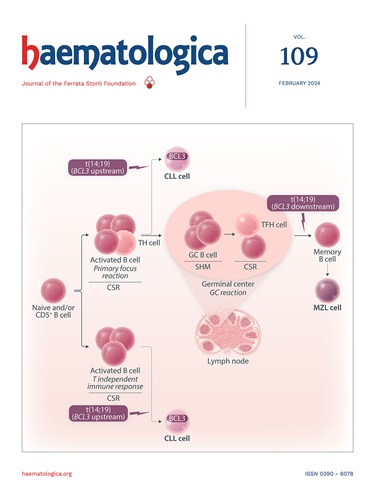Risk prediction in diffuse large B-cell lymphoma improves when combining baseline PET features with interim PET response.
IF 8.2
1区 医学
Q1 HEMATOLOGY
引用次数: 0
Abstract
Accurate detection of patients at high risk of treatment failure following first line immunochemotherapy in diffuse large B-cell lymphoma (DLBCL) is of paramount importance as patients might benefit from early treatment escalation. Recently, we introduced the International Metabolic Prognostic Index (IMPI) based on metabolic tumor volume (MTV), age and stage that outperformed the International Prognostic Index. However, radiomic features such as the maximum distance between the largest lesion and another lesion (Dmaxbulk) or the peak standardized uptake value (SUVpeak) along with early treatment response at interim positron emission tomography (iPET) based on ΔSUVmax may have additional predictive value. We tested different models for risk prediction aiming to develop a dynamic risk tool. All patients within the PETRA database with newly diagnosed DLBCL treated with R-CHOP, who had available clinical data, baseline PET and iPET scans were included. The optimal transformation of Dmaxbulk, SUVpeak and ΔSUVmax was determined by choosing the best fitting Cox regression model with lowest Akaike Information Criterion (AIC), while the cross-validated c-index was obtained as a measure for discrimination. Risk models were developed using clinical, baseline PET and iPET data. The best risk model was compared to the IMPI and our subsequent ClinicalPET model. 1014 patients were included in the analyses. Best baseline model included age, MTV and Dmaxbulk (AIC 3208.89, c-index 0.70). Adding iPET response further improved outcome prediction (AIC 3140.36, c-index 0.74) with wider segregation of Kaplan Meier-curves and improved rates of correct risk classification, supporting the value of a dynamic risk assessment in DLBCL.将基线PET特征与中期PET反应相结合可提高弥漫性大b细胞淋巴瘤的风险预测。
弥漫性大b细胞淋巴瘤(DLBCL)一线免疫化疗后治疗失败高风险患者的准确检测至关重要,因为患者可能从早期治疗升级中获益。最近,我们推出了基于代谢性肿瘤体积(MTV)、年龄和分期的国际代谢预后指数(IMPI),优于国际预后指数。然而,放射学特征,如最大病变与另一个病变之间的最大距离(Dmaxbulk)或峰值标准化摄取值(SUVpeak)以及基于ΔSUVmax的中期正电子发射断层扫描(iPET)的早期治疗反应,可能具有额外的预测价值。我们测试了不同的风险预测模型,旨在开发一个动态的风险工具。PETRA数据库中所有接受R-CHOP治疗的新诊断的DLBCL患者,包括有可用临床数据、基线PET和iPET扫描的患者。选择最优拟合的Cox回归模型,以最低的秋池信息准则(Akaike Information Criterion, AIC)确定Dmaxbulk、SUVpeak和ΔSUVmax的最优变换,并获得交叉验证的c-index作为判别指标。使用临床、基线PET和iPET数据建立风险模型。将最佳风险模型与IMPI和我们随后的ClinicalPET模型进行比较。1014例患者纳入分析。最佳基线模型包括年龄、MTV和Dmaxbulk (AIC 3208.89, c-index 0.70)。加入iPET反应进一步改善了预后预测(AIC 3140.36, c-index 0.74), Kaplan meier曲线分离更广,正确风险分类率更高,支持动态风险评估在DLBCL中的价值。
本文章由计算机程序翻译,如有差异,请以英文原文为准。
求助全文
约1分钟内获得全文
求助全文
来源期刊

Haematologica
医学-血液学
CiteScore
14.10
自引率
2.00%
发文量
349
审稿时长
3-6 weeks
期刊介绍:
Haematologica is a journal that publishes articles within the broad field of hematology. It reports on novel findings in basic, clinical, and translational research.
Scope:
The scope of the journal includes reporting novel research results that:
Have a significant impact on understanding normal hematology or the development of hematological diseases.
Are likely to bring important changes to the diagnosis or treatment of hematological diseases.
 求助内容:
求助内容: 应助结果提醒方式:
应助结果提醒方式:


